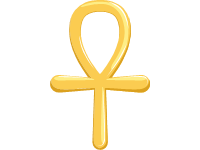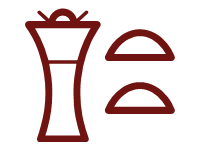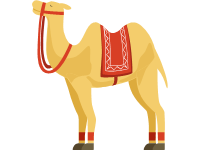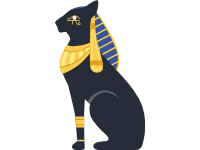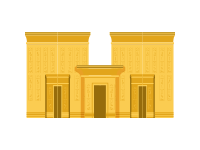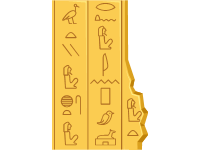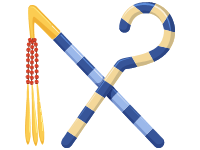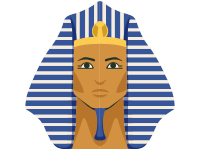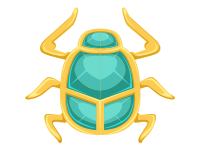| |
Anubis or Inpu, Anpu in Ancient Egyptian is the Greek name of the god of death, mummification, embalming, the afterlife, cemeteries, tombs, and the Underworld, in ancient Egyptian religion, usually depicted as a canine or a man with a canine head. Archeologists have identified Anubis's sacred animal as an Egyptian canid, the African golden wolf. The African wolf was formerly called the 'African golden jackal', until a 2015 genetic analysis updated the taxonomy and the common name for the species. As a result, Anubis is often referred to as having a 'jackal' head, but this 'jackal' is now more properly called a 'wolf'.
Like many ancient Egyptian deities, Anubis assumed different roles in various contexts. Depicted as a protector of graves as early as the First Dynasty (c. 3100 – c. 2890 BC), Anubis was also an embalmer. By the Middle Kingdom (c. 2055 – 1650 BC) he was replaced by Osiris in his role as lord of the underworld. One of his prominent roles was as a god who ushered souls into the afterlife. He attended the weighing scale during the 'Weighing of the Heart,' in which it was determined whether a soul would be allowed to enter the realm of the dead.Despite being one of the most ancient and 'one of the most frequently depicted and mentioned gods' in the Egyptian pantheon, Anubis played almost no role in Egyptian myths.
Anubis was depicted in black, a color that symbolized regeneration, life, the soil of the Nile River, and the discoloration of the corpse after embalming. Anubis is associated with his brother Wepwawet, another Egyptian god portrayed with a dog's head or in canine form, but with grey or white fur. Historians assume that the two figures were eventually combined. Anubis' female counterpart is Anput. His daughter is the serpent goddess Kebechet.
| |
Bastet or Bast was a goddess of ancient Egyptian religion, worshiped as early as the Second Dynasty (2890 BCE). Her name also is rendered as B'sst, Baast, Ubaste, and Baset. In ancient Greek religion, she was known as Ailuros.
Bastet was worshiped in Bubastis in Lower Egypt, originally as a lioness goddess, a role shared by other deities such as Sekhmet. Eventually Bastet and Sekhmet were characterized as two aspects of the same goddess, with Sekhmet representing the powerful warrior and protector aspect and Bastet, who increasingly was depicted as a cat, representing a gentler aspect
| |
Osiris is the god of fertility, agriculture, the afterlife, the dead, resurrection, life, and vegetation in ancient Egyptian religion. He was classically depicted as a green-skinned deity with a pharaoh's beard, partially mummy-wrapped at the legs, wearing a distinctive atef crown, and holding a symbolic crook and flail. He was one of the first to be associated with the mummy wrap. When his brother, Set, cut him up into pieces after killing him, Isis, his wife, found all the pieces and wrapped his body up, enabling him to return to life. Osiris was at times considered the eldest son of the earth god Geb and the sky goddess Nut, as well as being brother and husband of Isis, with Horus being considered his posthumously begotten son. He was also associated with the epithet Khenti-Amentiu, meaning 'Foremost of the Westerners', a reference to his kingship in the land of the dead. Through syncretism with Iah, he is also a god of the Moon.
Osiris can be considered the brother of Isis, Set, Nephthys, and Horus the Elder, and father of Horus the Younger. The first evidence of the worship of Osiris was found in the middle of the Fifth Dynasty of Egypt (25th century BC), although it is likely that he was worshiped much earlier; the Khenti-Amentiu epithet dates to at least the First Dynasty, and was also used as a pharaonic title. Most information available on the Osiris myth is derived from allusions contained in the Pyramid Texts at the end of the Fifth Dynasty, later New Kingdom source documents such as the Shabaka Stone and the 'The Contendings of Horus and Seth', and much later, in narrative style from the writings of Greek authors including Plutarch and Diodorus Siculus.
Osiris was the judge of the dead and the underworld, and the agency that granted all life, including sprouting vegetation and the fertile flooding of the Nile River. He was described as 'He Who is Permanently Benign and Youthful' and the 'Lord of Silence'.The kings of Egypt were associated with Osiris in death – as Osiris rose from the dead so they would be in union with him, and inherit eternal life through a process of imitative magic.
Through the hope of new life after death, Osiris began to be associated with the cycles observed in nature, in particular vegetation and the annual flooding of the Nile, through his links with the heliacal rising of Orion and Sirius at the start of the new year. Osiris was widely worshipped until the decline of ancient Egyptian religion during the rise of Christianity in the Roman Empire.
| |
Ra is the ancient Egyptian deity of the sun. By the Fifth Dynasty in the 25th and 24th centuries BC, he had become one of the most important gods in ancient Egyptian religion, identified primarily with the noon sun. Ra was believed to rule in all parts of the created world: the sky, the Earth, and the underworld. He was the god of the sun, order, kings, and the sky.
Ra was portrayed as a falcon and shared characteristics with the sky god Horus. At times the two deities were merged as Ra-Horakhty, 'Ra, who is Horus of the Two Horizons'. In the New Kingdom, when the god Amun rose to prominence he was fused with Ra into Amun-Ra.
The cult of the Mnevis bull, an embodiment of Ra, had its center in Heliopolis and there was a formal burial ground for the sacrificed bulls north of the city.
All forms of life were believed to have been created by Ra. In some accounts, humans were created from Ra's tears and sweat, hence the Egyptians call themselves the 'Cattle of Ra'. In the myth of the Celestial Cow, it is recounted how mankind plotted against Ra and how he sent his eye as the goddess Sekhmet to punish them.
| |
A sphinx is a mythical creature with the head of a human, a falcon, a cat, or a sheep and the body of a lion with the wings of an eagle.
In Greek tradition, the sphinx has the head of a woman, the haunches of a lion, and the wings of a bird. She is mythicized as treacherous and merciless, and will kill and eat those who cannot answer her riddle. This deadly version of a sphinx appears in the myth and drama of Oedipus.
Unlike the Greek sphinx, which was a woman, the Egyptian sphinx is typically shown as a man. In addition, the Egyptian sphinx was viewed as benevolent but having a ferocious strength similar to the malevolent Greek version. Both were thought of as guardians and often flank the entrances to temples.
In European decorative art, the sphinx enjoyed a major revival during the Renaissance. Later, the sphinx image, initially very similar to the original Ancient Egyptian concept, was exported into many other cultures, albeit they're often interpreted quite differently due to translations of descriptions of the originals and through the evolution of the concept in relation to other cultural traditions.
Sphinx depictions are generally associated with architectural structures such as royal tombs or religious temples.
| |
Thoth is an ancient Egyptian deity. In art, he was often depicted as a man with the head of an ibis or a baboon, animals sacred to him. His feminine counterpart was Seshat, and his wife was Ma'at. He was the god of wisdom, writing, hieroglyphs, science, magic, art, judgment, and the dead. His Greek equivalent is Hermes.
Thoth's chief temple was located in the city of Hermopolis. Later known as el-Ashmunein in Egyptian Arabic, it was partially destroyed in 1826.
In Hermopolis, Thoth led 'the Ogdoad', a pantheon of eight principal deities, and his spouse was Nehmetawy. He also had numerous shrines in other cities.
Thoth played many vital and prominent roles in Egyptian mythology, such as maintaining the universe, and being one of the two deities (the other being Ma'at) who stood on either side of Ra's solar barque. In the later history of ancient Egypt, Thoth became heavily associated with the arbitration of godly disputes, the arts of magic, the system of writing, the development of science, and the judgment of the dead.
| |
The Eye of Horus, also known as wadjet, wedjat or udjat, is an ancient Egyptian symbol of protection, royal power, and good health. The Eye of Horus is similar to the Eye of Ra, which belongs to a different god, Ra, but represents many of the same concepts.
Funerary amulets were often made in the shape of the Eye of Horus. The symbol 'was intended to protect the pharaoh in the afterlife' and to ward off evil. Ancient Egyptian and Middle-Eastern sailors would frequently paint the symbol on the bows of their vessels to ensure safe sea travel.
|
|
